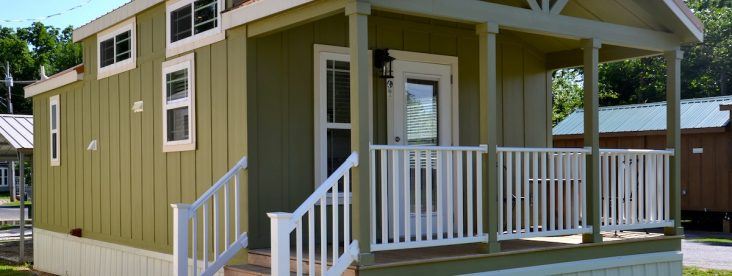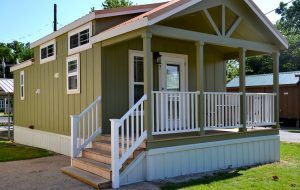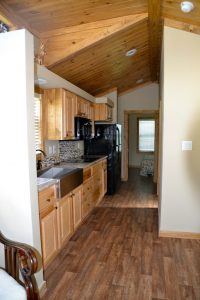‘Tiny House’ trend emerging in Arkansas with seniors in Northwest Arkansas, Fort Smith
by August 10, 2016 2:54 pm 12,408 views

At age 64, Betsy McNeil is getting rid of her furniture, her clothes and her artwork, and she is downsizing. Really downsizing. In mid-August, McNeil will move into a 399-square-foot house on Bloyd Mountain, near West Fork. Her new home will be slightly bigger than the size of the average master bedroom.
McNeil exemplifies a small, but growing segment of the population that is moving into “tiny” houses. The typical American home is 2,600 square feet, while the typical tiny house is 100 to 400 square feet.
According to Ryan Mitchell, owner of the website, TheTinyLife.com, the nationwide trend is “a social movement of people who radically downsize the space in which they live because of their environmental concerns, their financial concerns and their desire for more time and freedom.”
The trend is reflected in the millennial generation’s desire to simplify living in order to cut costs, to trade accumulating possessions for having experiences, and to reduce their carbon footprint. The movement is growing in the United States as evidenced by the number of television shows (at least four) dedicated to tiny living, numerous blogs on tiny house living, and a lot of chatter on social media. However, it is hard to track because tiny homes are so small they don’t require a building permit like other houses, and are often on wheels and classified as a recreational vehicle or a mobile home.
Kathy Schmelzer’s decision to move into a 400-square-foot house in Fort Smith came as a result of wanting to reduce her carbon footprint, wanting to live in a more convenient space so that she had more free time, and wanting to have less space to keep dust-free to alleviate asthma attacks caused by her severe allergies.
Schmelzer, a widow since 2009, works part time and has been in her tiny house for five years, after living with her husband in homes ranging from 3,000 to 2,500 square feet. Like many in the tiny home movement, she became concerned about how her every day living was affecting the world around her.

“It all led from the realization of the environment. It has to start with me,” she said. “I like an air conditioner. I don’t want to go back to open windows in an Arkansas summer. Don’t get me wrong. But, do I need to be running a ten-ton air conditioner? Do I need to be running pool pumps?”
DON’T WANT TO BE ‘TIED’ TO A HOUSE
Northwest Arkansas is seeing the beginning of its own tiny house movement, but in a somewhat unexpected group – senior citizens.
Widowed for 15 years, McNeil lived most recently in a three bedroom, 1,600-square-foot house in Bella Vista. But, when her daughter and her family unexpectedly moved to the area and decided to build a house on 30 acres outside of West Fork, McNeil decided to join them there.
McNeil’s new tiny home will be a “park” model, meaning it is on a trailer and can be moved. If in the coming years she decides to relocate, or if her lifestyle changes, the house can be moved off the property and her family won’t have to deal with a permanent structure on their land. McNeil, a self-employed spiritual director, will continue to work part time traveling to various churches in the area. She is in excellent health, with a very active lifestyle.
“I’m not to the age where I need to live with my kids yet, nor do I want to. I’m looking forward to a simple lifestyle. I will not have a lot of material goods to take care of. I will not have a lot of maintenance issues.” McNeil said. “I don’t want to be tied to my house. I want to be able to come and go. I do not want to spend a lot of time cleaning a 2,000 square foot house.”
MOVING ACROSS GENERATIONS
McNeil bought her tiny house from Dave Gallo, owner of Eagle Homes on Olive, in Rogers. Gallo is also interested in tiny houses, but his vision is for an entire neighborhood of them. In keeping with that goal, he is offering a tiny home community, Eagle Homes on Olive, for ages 55 and up.
Gallo’s path to focusing on tiny homes came about as he studied trends in the country and read a book by Greg McKeown, entitled “Essentialism: The Pursuit of Less,” which deals with prioritizing your life. In the book, McKeown stresses focusing on a few important things in your life and doing away with the rest.
“It wasn’t a tiny house trend that led me down this path. It was more of essentialism, the minimalist mindset. There’s a mindset shift going on in America where people don’t want to be burdened down with a heavy debt load of owning a $200,000 house,” Gallo said. “They don’t want to spend hours cleaning their house. They want to put their kayak on their jeep on the weekend and go. They want to live outside their house.”
Gallo saw the tiny house movement as a by-product of this mindset shift. As for why he chose to focus his community on age 55 and up, Gallo said the minimalist trend is moving to the older generation.

“I see it across generations. The millennials are actually impacting their mom and dad,” he said.
Mitchell’s website indicates that two out of five tiny home owners across the country are over the age of 50 and that number is growing – although it is unclear his information source on the statistic.
While there are various reasons for the growth, the younger generation is interested in tiny houses for their parents, or for a widowed parent, as a transition between their larger family home and an assisted living facility. A tiny house offers home ownership to senior citizens without the massive upkeep of a large house.
Gallo told of one woman who said her father would still be alive if a tiny home had been available. Instead, the family moved him into an apartment and he lost interest in life because he no longer felt of any value. She said because there is value in owning something and pride and homeownership, having a small home to care for, and a flowerbed to work in, would have given him something to live for. Such stories validate Gallo in his decision this past year to leave his job as a Walmart supplier for Big Heart Pet Brands and open Eagle Homes on Olive.
TINY CAN BE CUSTOM
McNeil said she appreciates the fact that she was able to choose everything about her home – from the floor plan, to adding more windows, to choosing gas or propane appliances. Her home cost about $52,000, including the upgrades. The price does not include the cost of septic, electric, tapping into the water supply or the land it will sit on.
“I don’t know that I would want to go into a small cookie cutter that didn’t fit my lifestyle,” she said. “The ability to have a custom home was very appealing to me.”
Buyers can purchase a pre-made tiny house from Gallo, ranging in size from 384 to 399 square feet, to be delivered to a location of their choosing or, if they are over age 55, they can lease one of the 28 lots at the community on Olive Street. Lot rental, including water, sewer, trash and lawn care, ranges from $300 to $330 a month.
Gallo was fortunate in his ability to acquire the land in Rogers. In many parts of the country the dilemma after buying a tiny home is where to put it. Many cities set a minimum size for houses and since many tiny homes are on trailers, most restrict them to a recreational vehicle or mobile home park. According to Ashley Kupillas, Rogers city planner, if a home is not built on site and comes in on wheels or on a truck, it is considered a mobile home and is required to be in a mobile home park.
“We don’t have many areas in Rogers that are zoned for (mobile homes). You can build a tiny home in a residential area if you’re building it from the ground up on that property and it has a foundation and it’s not rolled in and pre-purchased,” Kupillas said.
The lot where Eagle Homes is located was previously zoned as a mobile home/recreational vehicle park and so Gallo did not encounter restrictions in placing his tiny home community there. Kupillas also said Rogers does not have minimum size restrictions on homes and so the small square footage of Gallo’s houses is not an issue.
OTHER REASONS TO GO TINY
While the appeal of tiny homes is varied, Gallo said his research showed that people are looking for peaceful, affordable housing that is flexible and freeing. He said that his tiny home community offers those four benefits. For example, since he owns the land and will rent the lots, he can set rules to ensure a peaceful environment in the community.
His tiny homes are affordable for seniors, because they can be completely set up with delivery, taxes, skirting, steps, parking space and utility hook-ups for as little as $40,000. If every upgrade offered was added to the home, it could run around $65,000. According to the U.S. Census Bureau, the average cost of a home in the United States is more than $200,000.
Tiny homes across the country typically range in price from $23,000 for a “do-it-yourselfer” up to $70,000 for one that is pre-built and has upgrades.
For older Americans, many on fixed incomes, a lower cost of living is of utmost importance. Nearly 55% of workers age 55 and older have saved less than $25,000 for retirement, according to the nonprofit Employee Benefit Research Institute. That is far less than most financial planners recommend.
With less house to care for, Gallo said, the residents in his community have the flexibility and freedom to focus on enjoying experiences in their lives.
TINY HOME DRAWBACKS
With downsizing, Schmelzer of Fort Smith, like every tiny house homeowner, had to rethink her relationship with her material possessions.
“I came through a long process of looking at stuff and realizing that I could become a slave to that stuff,” she said. “When I started coming up with this idea of smaller, smaller, smaller, there were a lot of questions I asked myself… Do I need service for 12? Do I need all this crystal? Do I need…. No! Why do I have it? Why am I dusting it?”
However, living in such a small space means no room for things most people take for granted. McNeil said she will only have one small closet and so she can have clothes for only one season.
Schmelzer compensates for some things she misses like buying books on the Kindle or digitizing photos. But not everything can be handled that way. For instance, Schmelzer’s house is too small to store a suitcase. There is no room for Christmas decorations. She can’t have overnight guests because there is no place for them to sleep.
She makes do by storing her suitcase at her workplace, going to her daughter’s home at Christmas and sending her guests to a nearby bed and breakfast. Family heirlooms, such as a beloved dining table or china cabinet, many times must go when moving into a tiny house, because there is no room for them.
“If these houses aren’t big enough for your must-haves, then don’t buy one,” Gallo said he tells potential clients. “Because you’re going to be miserable getting rid of your heirlooms. … Don’t buy something where you’re going to have to give up something you don’t really want to.”
Schmelzer has come to terms with the sacrifices.
“I had to be good with the choice to do this, or I think every inconvenience would be blossomed into a big burden instead of just a hurdle of – oh well we have to figure this out,” she said.
Overall Schmelzer is satisfied with her choice to live in a tiny space.
“This is good for me right now, where I am in life and I have no anxiety about this being the rest of my life. If it is, it is.”
